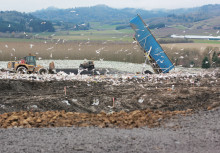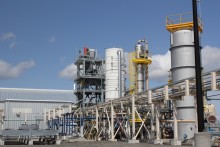Source: opb.org
Published: January 11, 2013

Several new projects in Oregon propose to turn garbage into energy sources including hydrogen, crude oil and methane.
With more and more waste-to-energy technologies emerging, Oregon environmental regulators are updating their permitting system to accommodate them. A public meeting next week will address new rules for so-called “conversion technology” that turns trash into energy.
“Our rules were written 20 years ago and didn’t really anticipate or take into account these types of facilities,” said Brian Fuller of Oregon Department of Environmental Quality. “We’ve been seeing more and more interest in these types of facilities, and more questions to DEQ about how these facilities would be regulated.”
While they’re not as effective as recycling, he said, projects that turn plastics into oil, garbage to gas and food scraps to electricity offer waste management options that are greener than landfilling or incinerating trash.
Three projects in particular have motivated DEQ to propose new rules for facilities that turn trash into energy:
Vaporizing Trash In Arlington

InEnTec uses plasma technology to turn garbage into hydrogen gas.
Jeff Surma is co-founder of a company called InEnTec, a company that has developed a way to essentially vaporize solid waste using plasma technology. Its plasma arc gasification facility is nearing completion at Waste Management’s Columbia Ridge landfill in Arlington.
The plasma technology is “essentially a controlled bolt of lightning that we operate inside a chemical reactor,” Surma said. At Columbia Ridge, the system takes in municipal solid waste, i.e. garbage, breaks it down into its elements and reforms them into hydrogen gas.
Hydrogen is used for industrial manufacturing – for making silicon chips, for example – and it can also be used to make electricity in fuel cells. The unit at the landfill in Arlington still needs a hydrogen purification unit to complete the process, Surma said, but by summertime the facility should be fully operational.
“We’ve been working at this for a long time, and it’s finally at a point where it’s commercially viable,” said Surma.
The hydrogen produced at the plant would compete with hydrogen produced with natural gas at other facilities, but Surma said there are companies looking for “green hydrogen” that hasn’t been derived from a fossil fuel.
Plastics To Oil In Portland, Brooks
The Beaverton company Agylix has found a way to turn non-recycleable plastics into crude oil using a chemical process called pyrolysis. The process heats the waste plastic into a gas and condenses it into synthetic crude oil, removing impurities so it can be refined into fuel later. Its technology is used at a demonstration facility in Tigard, but there are also two commercial-scale projects in the works: One at the Agri-Plas recycling facility in Brooks, and one at a Waste Management facility in Portland.
The Agri-Plas facility would take materials that wouldn’t otherwise be recyclable – like plastic planting pots used in agriculture – and turn them into a synthetic crude-oil that can be sold to refineries. The facility would be able to produce roughly 2.6 million gallons of oil a year from 23 million pounds of plastic.
Anaerobic digestion

JC Biomethane is building Oregon’s first non-farm methane digester to turn food scraps and yard waste into electricity in Junction City.
A company called JC Biomethane is building a plant in Junction City that will put organic waste – food scraps and yard debris – into a digester that produces methane gas. It’s a lot like the methane digesters farmers are now using to generate electricity from cow manure.
“You’re utilizing anaerobic bacteria to consume volatile organic material and create methane,” said project spokesman Dean Foor. “The biological part is the same. The tank shape and mixing technology are different.”
The methane is burned to turn a turbine that creates electricity. The Junction City facility will have 1.55 megawatts of electricity – enough to power about 1,500 homes – when it is completed later this year.
The waste this company is using would otherwise be composted, but Foor argues the anaerobic digestion creates fewer greenhouse gas emissions than composting, which emits nitrous oxides. The process will also produce a compost tea that Foor said will offset at least 1,000 acres of conventional fertilizers made from fossil-fuels.
Fuller said the new rules will take environmental impacts such as odor issues from anaerobic digesters into account, as well as potential contaminants in oil made from plastics. The agency’s air and water quality permits will address pollution emitted by the new facilities.
Waste-to-energy technologies are a useful tool in reducing waste, Fuller said, but they’re not as efficient as recycling.
“When you send a milk jug to a recycling plant to be made into another container the energy savings are greater than the energy you’re creating with the oil,” he said. “In theory, you can recycle something over and over again, but here if you’re taking plastic and turning into oil and the oil is burned as fuel, that resource is gone.”
